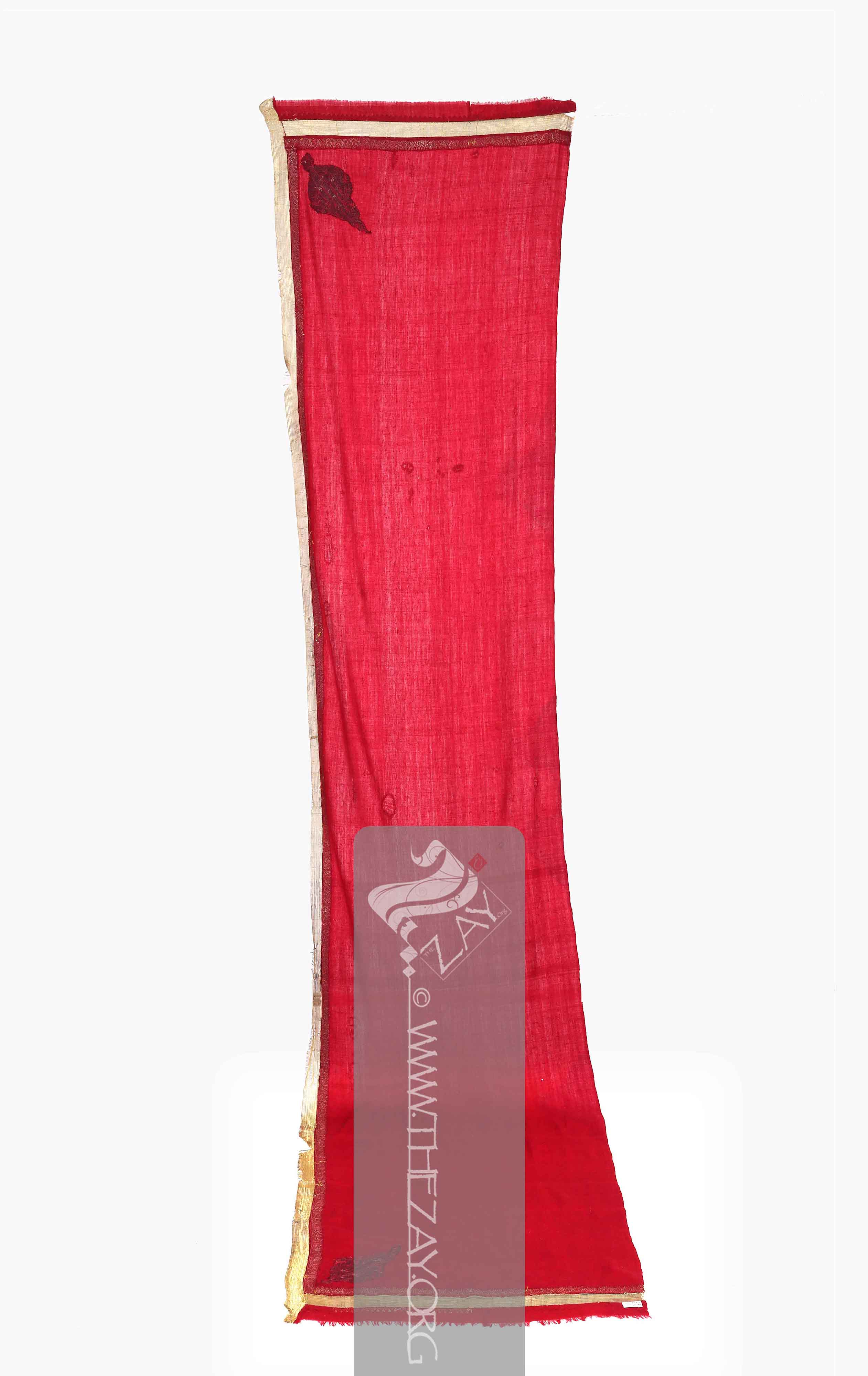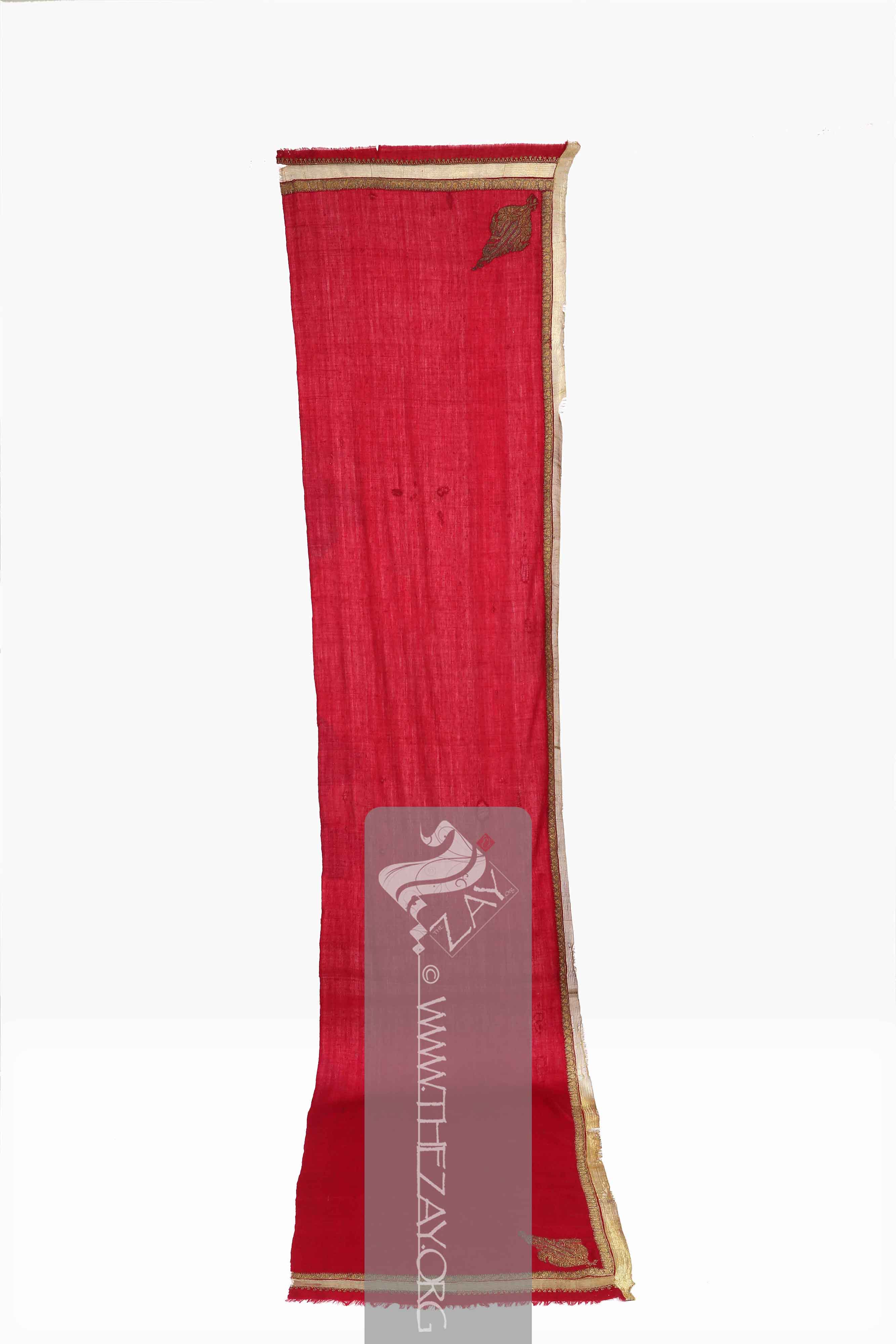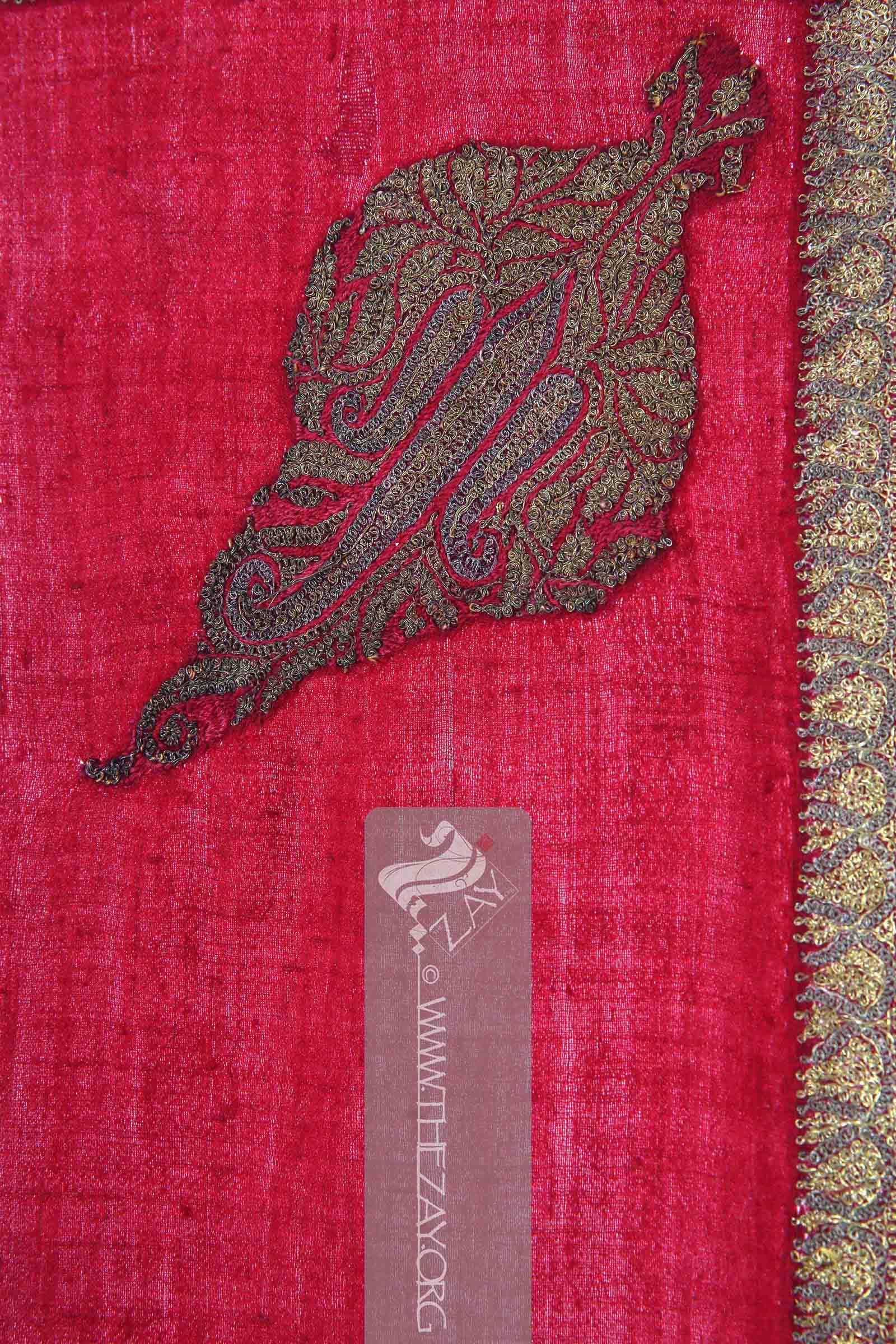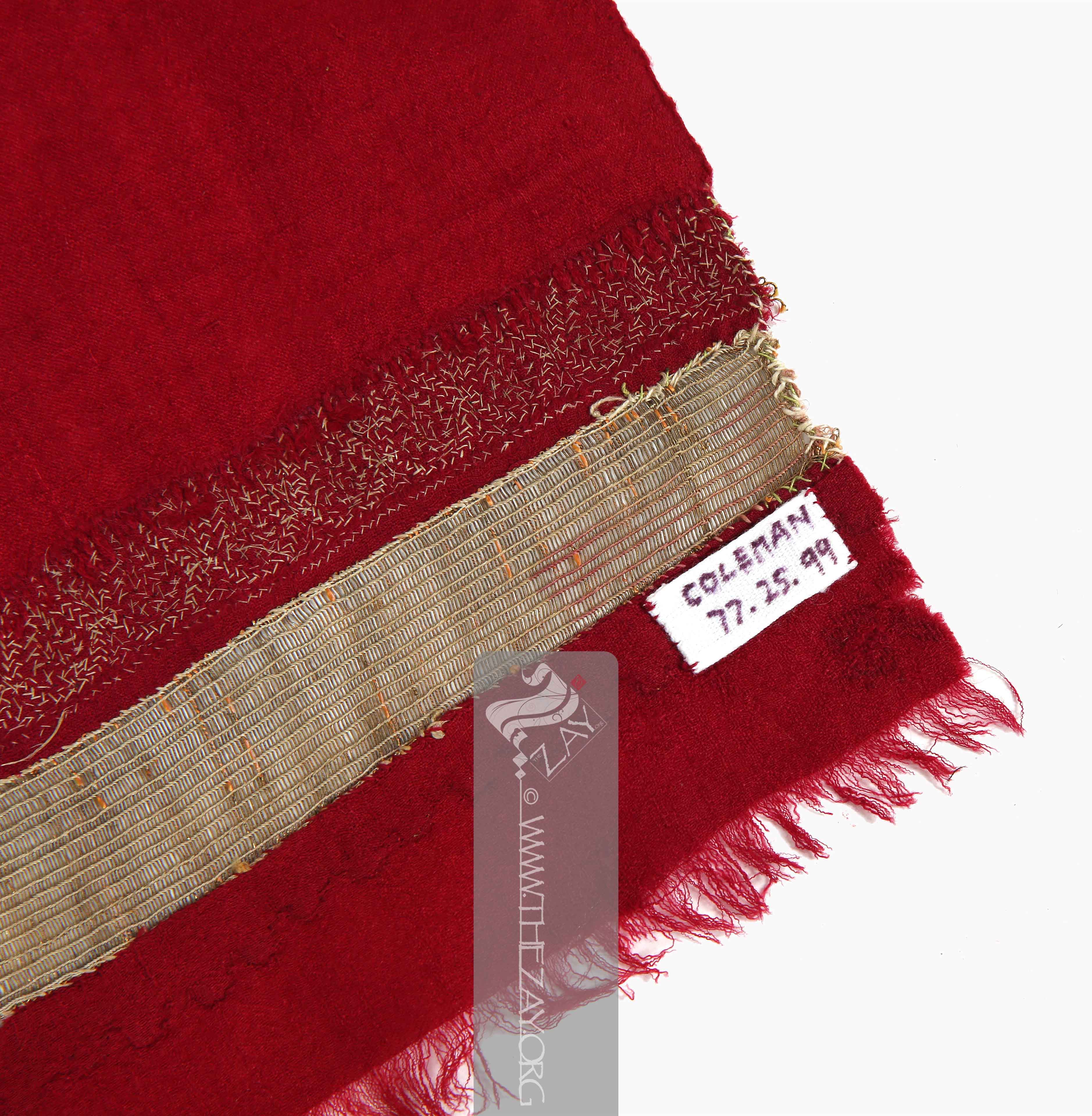Object History This silk long stole/veil (
dupatta
Dūpatta: (Sanskrit: du – double or twin and patta – a piece of cloth or shash), a portmanteau of the two Sanskrit words it means a head scarf
Scarf: (English), usually a rectangular piece of cloth loosely worn over the shoulders, upper body and arms, and sometimes also over the head. doubled as a wrap used by women in the Indian subcontinent for modesty and is an essential part of their everyday ethnic garments.) dating back to the late- 19th century was originally a part of the Dr Joan Coleman Collection. It was first purchased on July 28, 1977, at an auction in Christie’s, London, and later The
Zay
Zay: (Arabic: costume, Pl. azyaā’), a set of clothes in a style typical of a particular country or historical period. Initiative managed to acquire it from Kerry Taylor Auctions in 2020.
Dr Joan Coleman began collecting shawls in 1976 and developed her lifelong passion for collecting. She was a regular at the London salesroom of Christie’s, Sotheby’s, and Phillips – three of the most outstanding auction houses of the period in the world – getting to know the dealers and learning in the process. She acquired vast knowledge and dedicated hours carefully cataloguing her ever-growing collection. She intended to loan her collection to different museums and institutions for the benefit of learning and education. Her collection is one of the largest and the finest private
shawl
Shawl: (Persian: shāl from Hindi: duśālā – Shoulder Mantle), a shawl is a South Asian version of a scarf
Scarf: (English), usually a rectangular piece of cloth loosely worn over the shoulders, upper body and arms, and sometimes also over the head. worn or wrapped loosely over the shoulders and is usually made of wool. collections to have ever graced the world, with shawls ranging from Kashmir,
Paisley
Paisley: (Scottish Gaelic, Pàislig: a town in Scotland), often called buta
Būta: (Anglicized Persian: boteh – Pinecone shaped motif), known as paisley in English it is the almond or pinecone-shaped motif, especially in textiles. It is believed to have originated from the Cyprus tree a Zoroastrian symbol for life and eternity. In the current Indian context, however, it simply means motif., boteh, amli, or kalgi in the subcontinent and kazuwah in Arabic, is a Persian tear drop motif with a curved end specially in textiles. Its popularity and subsequent local production in 18th century at Paisley are responsible for its nomenclature., Edinburgh, Norwich, France, and Iran.
Object Features This
dupatta
Dūpatta: (Sanskrit: du – double or twin and patta – a piece of cloth or shash), a portmanteau of the two Sanskrit words it means a head scarf
Scarf: (English), usually a rectangular piece of cloth loosely worn over the shoulders, upper body and arms, and sometimes also over the head. doubled as a wrap used by women in the Indian subcontinent for modesty and is an essential part of their everyday ethnic garments. is a rectangular piece of bright
crimson
Crimson: (Persian/Arabic and Turkish: qirmiz or kirmiz – red), is a vivid red color originally made from the dried bodies of a scale insect of the Kermes genus native to the Mediterranean region and was used as a dye for clothing and textiles. silk fabric that was woven by hand on a loom, embellished with hand embroidery in gold and silver metal thread on a bright red base. The fabric has minimal, yet intricate stylised (
paisley
Paisley: (Scottish Gaelic, Pàislig: a town in Scotland), often called buta
Būta: (Anglicized Persian: boteh – Pinecone shaped motif), known as paisley in English it is the almond or pinecone-shaped motif, especially in textiles. It is believed to have originated from the Cyprus tree a Zoroastrian symbol for life and eternity. In the current Indian context, however, it simply means motif., boteh, amli, or kalgi in the subcontinent and kazuwah in Arabic, is a Persian tear drop motif with a curved end specially in textiles. Its popularity and subsequent local production in 18th century at Paisley are responsible for its nomenclature.) and floral couched embroidered motifs. The body of the fabric is plain, except for the two diagonal corners that mirror each other, and a broad gold and silver
gauze
Gauze: (English), very fine wire mesh transparent fabric of silk, linen, or cotton. edging border flanked by two lines of embroidered gold and silver floral motifs. The border is a separate patch that is stitched to the central panel and has a simple hem. It is interesting to note that the decorative pattern forming the border in this piece only runs along three sides of the central panel and ends in decorative fringes only at the
warp
Warp: One of the two basic components used in weaving which transforms thread or yarns to a piece of fabric. The warp is the set of yarns stretched longitudinally in place on a loom before the weft
Weft: one of the two basic components used in weaving that transforms thread or yarns into a piece of fabric. It is the crosswise thread on a loom that is passed over and under the warp threads. is introduced during the weaving process. ends.
It has a small rectangular piece of canvas stitched near one of the corners on the underside of the fabric that reads “COLEMAN 77.25.99” – the accession number of the piece while it was a part of the Dr Joan Coleman Collection.
The
Kashmiri
Kashmiri: (Hindustani: Kashmir – a region in South Asia), a term used to denote or identify anything related to the region – its people, their language, culture, art and craft, society etc. couching
Couching: (Latin: collocare – Place together), in needlework and embroidery couching is a technique in which yarn or other materials are laid across the surface of the ground fabric and fastened in place with small stitches of the same or a different yarn
embroidery in gold and silver threads (
tilla_dozi
Tillā_dozī: (Turkish: tel + -li – wire, string or cord and Persian: douzi – sewing or embroidery, synonyms: talli
Tallī: (Turkish: tel – wire, string), Gulf Arab – a woven braided trimming made with metal wire, threads and ribbons often sewn on detachable panels used as embellishments. Other – (Synonym: tulle_bi_talli
Tūlle_bi_tallī: (French: Tulle – a city in France where fine material for veil was first made; Turkish: tel – wire; Synonym: tariq; talli; badla; khus_dozi
Khus_dozi: (Persian: Khvosh – an Iranian province; dozi – needlework; Synonym: tariq; talli; tulle_bi_talli; badla), series of small metal knots made on a woven net ground as embellishment. The term is commonly used in Iran and parts of the Arabian Peninsula possibly because Khvosh was one of the centres for the craft.
), series of small metal knots made on a woven net ground as embellishment. The term is commonly used in the North African Arab region specifically in Egypt.
; tariq; badla; khus_dozi
Khus_dozi: (Persian: Khvosh – an Iranian province; dozi – needlework; Synonym: tariq; talli; tulle_bi_talli; badla), series of small metal knots made on a woven net ground as embellishment. The term is commonly used in Iran and parts of the Arabian Peninsula possibly because Khvosh was one of the centres for the craft.
), series of small metal knots made on a woven net ground as embellishment.
, tur_bi_talli
Tūr_bī_tallī: (English: tulle: netting, Arabic: talā, or talā’: paint or to coat, Turkish: tel: wire, synonyms: asīūṭī, tallī, tulle_bi_talli
Tūlle_bi_tallī: (French: Tulle – a city in France where fine material for veil was first made; Turkish: tel – wire; Synonym: tariq; talli; badla; khus_dozi
Khus_dozi: (Persian: Khvosh – an Iranian province; dozi – needlework; Synonym: tariq; talli; tulle_bi_talli; badla), series of small metal knots made on a woven net ground as embellishment. The term is commonly used in Iran and parts of the Arabian Peninsula possibly because Khvosh was one of the centres for the craft.
), series of small metal knots made on a woven net ground as embellishment. The term is commonly used in the North African Arab region specifically in Egypt.
, mnaqad/mnaghad, mukaish
Mukaish (Indian, synonyms: asūṭī, tallī, tur_bi_tallī/tulle_bi_talli, mnaqad/mnaghad, mukaish, badla/badlah, fardi, khus_dozi
Khus_dozi: (Persian: Khvosh – an Iranian province; dozi – needlework; Synonym: tariq; talli; tulle_bi_talli; badla), series of small metal knots made on a woven net ground as embellishment. The term is commonly used in Iran and parts of the Arabian Peninsula possibly because Khvosh was one of the centres for the craft.
). Indian embroidery technique where small rectangular strips of metal are squeezed shut around some threads of the fabric creating intricate shapes and designs., badla/badlah, fardi, khus_dozi
Khus_dozi: (Persian: Khvosh – an Iranian province; dozi – needlework; Synonym: tariq; talli; tulle_bi_talli; badla), series of small metal knots made on a woven net ground as embellishment. The term is commonly used in Iran and parts of the Arabian Peninsula possibly because Khvosh was one of the centres for the craft.
). Cotton linen or synthetic mesh hand embellished with flat strips of metal alloys coated with silver or gold squeezed shut around some threads of fabric creating intricate shapes and designs.), often shortened as tilla is a type of couching embroidery often done with metal beaten or wired metal thread. It is often used to decorate the borders, hems, necklines, and cuffs.
) adorns the two mirrored diagonal sides of the
dupatta
Dūpatta: (Sanskrit: du – double or twin and patta – a piece of cloth or shash), a portmanteau of the two Sanskrit words it means a head scarf
Scarf: (English), usually a rectangular piece of cloth loosely worn over the shoulders, upper body and arms, and sometimes also over the head. doubled as a wrap used by women in the Indian subcontinent for modesty and is an essential part of their everyday ethnic garments.. The motifs are floral teardrop-shaped leaves.
Given the bright red shade of the fabric along with its intricate tilla work there is a high possibility that it could have been a part of a woman’s wedding trousseau.
Links: 







